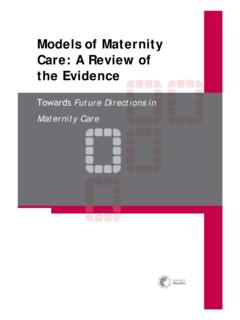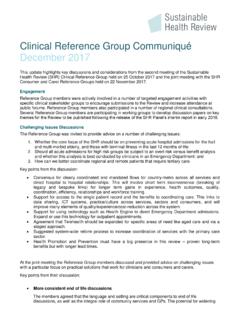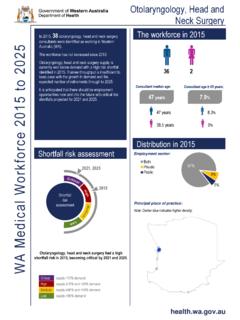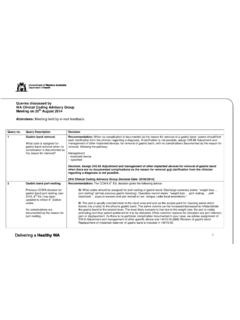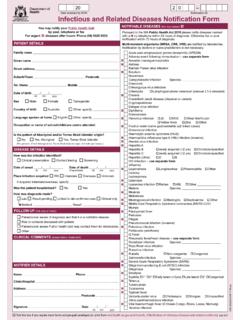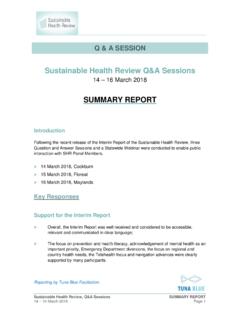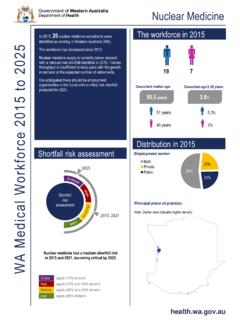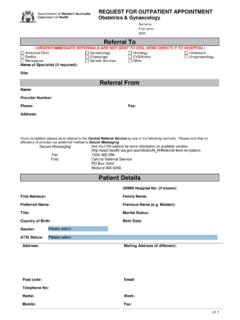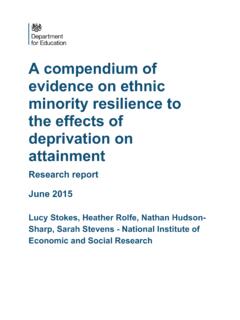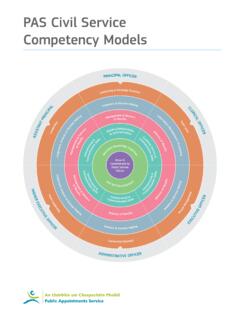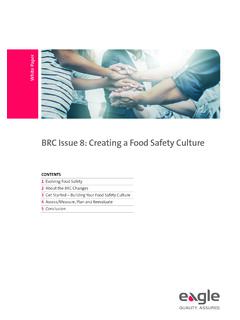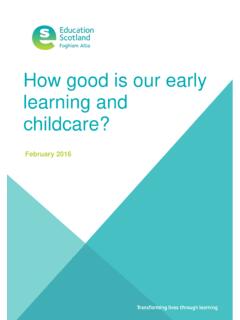Transcription of Nursing and Midwifery in Western Australia: A Discussion Paper
1 Nursing and Midwifery in Western Australia: A Discussion Paper Contents Executive summary 2. Definitions 4. Introduction 5. Current situation 5. Overview of the Nursing and Midwifery workforce in Western Australia 7. Enrolled nurses (EN) 8. Enrolled nurses - reform opportunities 8. Registered nurses (RN) 9. A) Newly qualified registered nurses (NQRN) 9. B) Registered nurses (RN) 9. C) Advanced-practice nurses (APN) 9. Registered nurses - reform opportunities 10. Nurse practitioners 10. Nurse practitioners - reform opportunities 11. Midwives 11. A) Newly qualified midwives (NQM) 11. B) Midwives 11. C) Endorsed midwives 11. Midwives - reform opportunities 12. Unregulated workforce 12. Assistants in Nursing (AIN) 12. Assistants in Nursing - reform opportunities 12.
2 Nursing and Midwifery healthcare transformation 13. 1. Leadership 13. 2. Scope of practice and workforce 14. 3. Education and training 16. 4. Digital and technological change 18. 5. Research and innovation 19. 6. Aged care sector 20. 7. Mental health sector 21. 8. Women and infants health sector: Maternity and child health 23. Next Steps 25. References 26. Appendix 1: Australian Qualifications Framework 28. Appendix 2: Nursing and Midwifery demographic, education and employment data in Western Australia 29. Nursing and Midwifery in Western Australia: A Discussion Paper | 1. Executive summary This Discussion Paper provides a preliminary overview of the Western Australian (WA). Nursing and Midwifery professions. Central to this report is the finding that many nurses and midwives, across all professional levels, are not working to their full scope of practice and remain an underutilised workforce in this State.
3 Leadership, maximising and expanding scopes of practice and implementation of Nursing and Midwifery -led models of interprofessional care are strongly featured themes throughout this Paper and have been identified as key reform opportunities. With the easing of post COVID-19 restrictions, WA's health system has entered the reform and transform phase of recovery. Implementation of models of care (MoC) that utilise the diverse skills from all professional levels of Nursing and Midwifery , are essential to meet the reform agenda for the WA health system. Sustainable change will be dependent on doing things differently with the resources we have. This will be challenging for some; for many it will provide opportunity. Capitalising on the strengths of WA's largest and widely respected healthcare workforce requires genuine innovation in our thinking, planning and implementation.
4 However, success relies on the systematic removal of organisational, regulatory and legislative barriers to enable this workforce to realise its potential. The Nursing and Midwifery workforce have enormous potential to meet the strategies outlined in the Sustainable Health Review (SHR)1. Investment is required to actively promote the benefits of lifelong learning, research and ongoing career growth. Upskilling in digital health literacy and mental health competencies are priority areas for reform across the entire Nursing and Midwifery professions. Positive patient-related outcomes are influenced by active partnerships, communication and healthy organisational environments. Co-design approaches underpinned by strong Nursing and Midwifery frameworks, with authentic, interprofessional and consumer collaboration, will drive cultural change within our healthcare system by cultivating a sense of empowerment, autonomy, and job satisfaction.
5 Five key themes aligning to the objectives of the SHR and WA COVID-19 recovery plan are identified: Theme 1: Maximising full and expanded scopes of practice Nurses, from enrolled nurses to nurse practitioners, and midwives across all professional levels are not working to their full scope of practice in WA. Maximising and expanding existing scopes of practice will provide low-cost, high impact sustainable solutions. Theme 2: Leadership Enhancement and Development Nurses and midwives must participate in the evolving healthcare environment. It is crucial that their significant contribution is not undervalued or hidden behind medically-led models. Nurses and midwives must be actively supported to strategically influence systemwide healthcare policy and operational decisions.
6 Representation must be strategic and workforce-led. Collaboration and connection between the Chief Nursing and Midwifery Office (CNMO), public and private health service providers, primary healthcare sector and community organisations are essential. 2 | Nursing and Midwifery in Western Australia: A Discussion Paper Theme 3: Nursing and Midwifery -led, interprofessional models of care Urgent investment to support the development of sustainable Nursing and Midwifery -led collaborative models of care must be actioned. An interprofessional, collaborative approach to areas of greatest need must be the priority. These include: mental health, Aboriginal health, chronic disease, aged care and end of life care. The Nursing and Midwifery workforce will be pivotal to ensuring COVID-19 surge readiness in vulnerable populations across all sectors.
7 Emphasis must be given to address the disparities in healthcare outcomes and access to healthcare. Theme 4: Growth of the nurse practitioner workforce WA is at critical risk of losing the nurse practitioner (NP) workforce. Effective use of NPs will meet many of the recommendations outlined in the SHR and support the COVID-19. recovery plan. The WA CNMO is leading a national, interjurisdictional strategic project to build, strengthen and advance the NP workforce where known challenges exist. Commitment, investment and support will be essential to progress this work. Theme 5: Building a statewide Nursing and Midwifery digital, research and innovation strategy Low-level digital health literacy is a major risk in the Nursing and Midwifery workforce. Development of digital literacy skills, with leadership opportunities to influence transformational change within digital health, is necessary.
8 Patient-centred and evidenced-based healthcare is not possible without investment and a clear, supported strategy for Nursing and Midwifery research and innovation. Building capacity and capability across all domains and levels of practice is critical to embedding a culture of innovative thinking and engagement in high-quality research design. Nursing and Midwifery in Western Australia: A Discussion Paper | 3. Definitions AIN Assistant in Nursing ANMAC Australian Nursing and Midwifery Accreditation Council APN Advanced Practice Nurse AQF Australian Qualification Framework CNMO Chief Nursing and Midwifery Office CNM Chief Nursing and Midwifery Officer CPD Continuing Professional Development ED Emergency Department EN Enrolled Nurse GREaT Get Real Experience and Try MBS Medicare Benefits Schedule MLCC Midwifery Led Continuity of Care MoCs Models of Care NMBA Nursing and Midwifery Board of Australia NP Nurse Practitioner NQM Newly Qualified Midwife NQRN Newly Qualified Registered Nurse PD Professional Development RN Registered Nurse SHR Sustainable Health Review WA Western Australia WAPHA WA Primary Health Alliance * Within Western Australia.
9 The term Aboriginal is used in preference to Aboriginal and Torres Strait Islander, in recognition that Aboriginal people are the original inhabitants of Western Australia. No disrespect is intended to our Torres Strait Islander colleagues and community. 4 | Nursing and Midwifery in Western Australia: A Discussion Paper Introduction In February 2020, the Western Australian (WA) Chief Nursing and Midwifery Officer, Dr Robina Redknap responded to a Ministerial request to provide an overview of Nursing and Midwifery in WA. The commencement of the review and Discussion Paper coincided with the COVID-19. global pandemic and WA Health's preparation for the predicted public health emergency. While strongly aligned to the priorities articulated in the SHR, the following Discussion Paper examines the influence of COVID-19 on the new normal' in healthcare, and future implications for the Nursing and Midwifery professions.
10 Future opportunities have been identified to inform strategy development and necessary resource allocation to achieve sustainable healthcare reform in WA. Current situation When the World Health Organisation designated 2020 as the International Year of the Nurse and Midwife, the COVID-19 pandemic could not have been foreseen. The global public health emergency has tested healthcare systems like never before. The public health preparation for COVID-19 in WA demonstrated the willingness of the Nursing and Midwifery workforce to be adaptable and flexible in response to anticipated clinical need. It is imperative to take the learnings from the COVID-19 experience and recommendations of the SHR to reimagine and transform WA's healthcare future. Strengths to provide a platform for future growth identified during the COVID-19.
